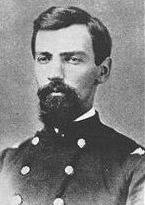The I Corps was deploying along McPherson Ridge with Cutler's brigade on the Union right and the Iron Brigade on the left. Facing Cutler was Joseph Davis's Mississippi Brigade. Davis was the nephew of president Jefferson Davis, and he advanced his men against Cutler. The Union troops were hard pressed, and eventually the three rightmost regiments were ordered to fall back. But the 147th New York did not get the order. The New Yorkers began to be surrounded by the Confederates, since the regiments next to them had retreated. However, General Wadsworth saw their plight and sent an officer to order them to retreat. With the order given they retreated at a run. The flagbearer was shot as he retreated and fell, and as the flag was a valuable symbol for the regiment, rather than leave it on the field a sergeant ripped the flag from the staff, rolled it up and carried it from the field. They had to pass through a railroad cut which went through the field, and many were shot by the Confederates as they stopped to climb the steep embankment.
The fight was also increasing in furry on the Union left. The Iron Brigade was sent into McPherson's woods against Archer's brigade. At first only the 2nd Wisconsin was sent in. The men had not been expecting a fight, so they had to load their rifles while running forward into battle. In the heavy fighting many men fell. The Yankees were soon reinforced by the rest of the Iron Brigade. They pushed through the woods and drove out the Confederates, taking those prisoner who did not retreat fast enough. Brigadier General James Archer himself was captured. His health had not been good and he did not have the strength to retreat. A private found him and brought him to the rear. He was the first general captured from the Army of Northern Virginia since Lee had taken command, a bad sign for Confederate victory in this battle.
On the right Davis's brigade pursued the rightmost regiments of Cutler's brigade. Wadsworth met this by sending in the 6th Wisconsin of the Iron Brigade, which had been held for such a need as this. The advance of the Wisconsin regiment was supported by several regiments from Cutler. Coming down on Davis's flank as they were advancing, they opened fire on the Confederates. Rufus Dawes, commanding the 6th Wisconsin, later wrote:
We were receiving a fearfully destructive fire from the hidden enemy. Men who had been shot were leaving the ranks in crowds. With the colors at the advance point, the regiment firmly and hurriedly moved forward, while the whole field behind streamed with men who had been shot,There was hard fighting over the colors of the 2nd Mississippi, which had been placed out in front of the railroad cut which the Confederates occupied. The entire Confederate color guard was killed or wounded and the flag staff was splintered with many holes through the flag. Many Yankees were shot as they rushed for the flag. Finally Corporal Frank Waller killed the Confederate flag bearer and ripped it from his hands, and continued firing at the Confederates. For this action he was awarded the Medal of Honor.
and who were struggling to the rear or sinking in death upon the ground. The only commands I gave, as we advanced, were, Align on the colors! Close up on the colors! Close up on the colors! The regiment was being so broken up that this order alone could hold the body together. Meanwhile the colors fell upon the ground several times but were raised again by the heroes of the color guard. Four hundred and twenty men started in the regiment from the turnpike fence, of whom about two hundred and forty reached the railroad cut. Years afterward I found the distance passed over to be one hundred and seventy-five paces. Every officer proved brave, true, and heroic in encouraging the men to breast the deadly storm, but the real impetus was the eager and determined valor of our men who carried muskets in the ranks.
Dawes
When the Federals reached the Confederate line they found that the rebels had become disorganized and fled into the railroad cut. Dawes continued:
My notice that we were upon the enemy, was a general cry from our men of: Throw down your muskets! Down with your muskets! Running forward through our line of men, I found myself face to face with hundreds of rebels, whom I looked down upon in the railroad cut, which was, where I stood, four feet deep. Adjutant Brooks, equal to the emergency, quickly placed about twenty men across the cut in position to fire through it. ... I shouted: Where is the colonel of this regiment? An officer in gray, with stars on his collar, who stood among the men in the cut ... promptly handed me his sword, and his men, who still held them, threw down their muskets. ... It would have been the handsome thing to say, Keep your sword, sir, but I was new to such occasions, and when six other officers came up and handed me their swords, I took them also. I held this awkward bundle in my arms until relieved by Adjutant Brooks.Around noon there was a lull in the fighting. Heth had expected to meet only light resistance on his move to Gettysburg, but instead he had gotten himself involved in a battle, and was loosing it. A. P. Hill and Lee had ridden to the sound of firing. Since the battle had already begun, Hill decided to deploy his entire corps. He placed them in a line which went along Herr ridge and then bent around on the left to Oak Hill. Artillery was deployed which opened fire on the Union line.
 |
| Union casualties |








1 comments:
Very useful info
Post a Comment